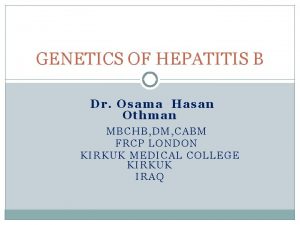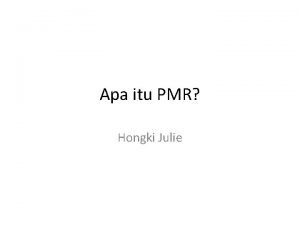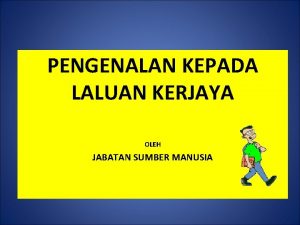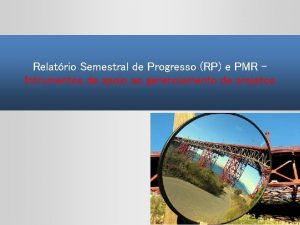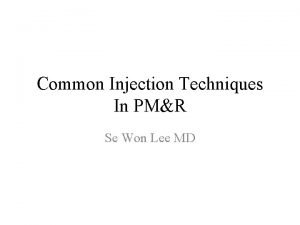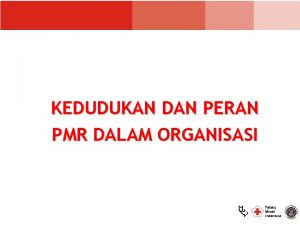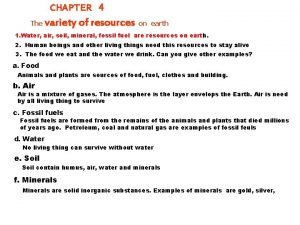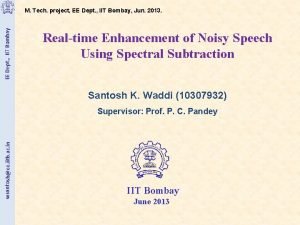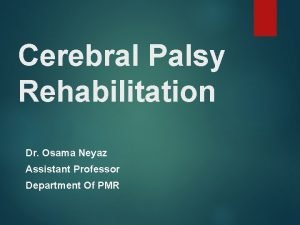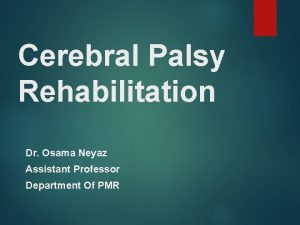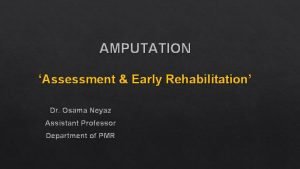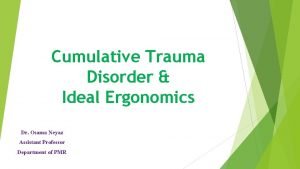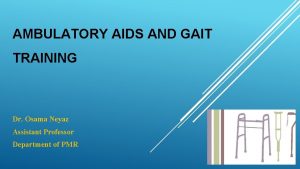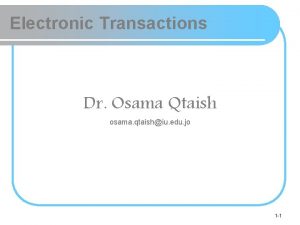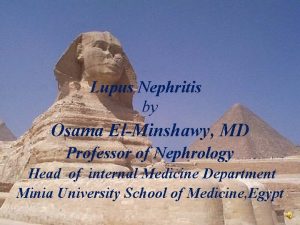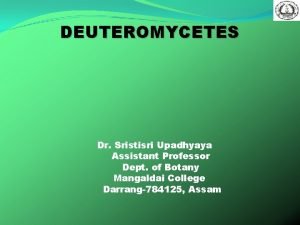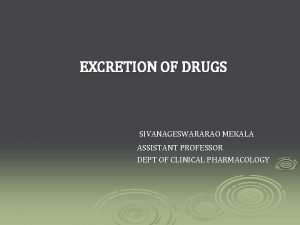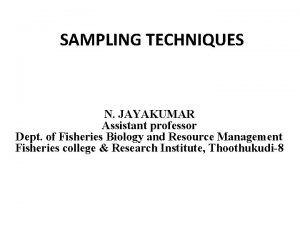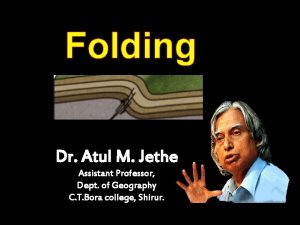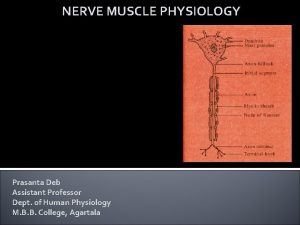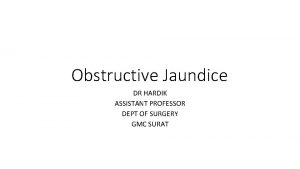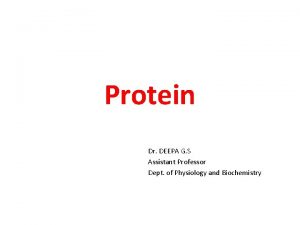Dr Osama Neyaz Assistant Professor Dept of PMR

































- Slides: 33

§ Dr. Osama Neyaz § Assistant Professor § Dept of PMR 1

§ Definitions § Types of prosthesis § Materials used § Prescription Criteria § Recent Advancement 2

Prosthetics § The branch of medicine dealing with the Study, Production and use of artificial body parts. Prosthesis § It is an artificial device extension that replaces a absence/lost body part. Prosthetist § The professional skilled in making or fitting prosthetic devices 3

Types based on Function: § Functional Prosthesis (Body-powered or Externally powered system ) § Cosmetic Prosthesis § Activity Specific Prosthesis Types Based on Design: § Exoskeletal Design § Endoskeletal Design 4

§ 1) Wood - commonly willow which is light weight, resilient & easily shaped. § 2) Aluminum & its alloys which is light weight, rust free & durable. § 3) Plastic and PVC materials. § 4) Carbon fiber light weight, strong , rust free and durable. § 5) Leather derivatives. § 6) costly metals Titanium, Ni, Co etc. 5

§ Body-powered prostheses: use forces generated by body movements transmitted through cables to operate joints and terminal devices. § Externally powered prostheses: use muscle contractions or manual switches to activate the prosthesis. 1) Myoelectrically controlled prosthesis - using surface electrodes to detect electrical activity from select residual limb muscles to control electric motors. 2) Switch-controlled prostheses - A switch can be activated by the movement of a remnant digit or part of a bony prominence against the switch or by a pull on a suspension 6

7

8

§ The two-site/two-function (dual-site) system § One-site/two-function (single-site) system 9

10

11

12

§ Multi-articulating myoelectric hands § Individual motors in each finger § Microprocessors continuously monitor the position of each finger § Automatically senses when a gripped item § Different grip patterns 13

1) Exoskeletal Design 2) Endoskeletal Design 14

§ Socket – Interface between stump and prosthesis- most important. § Suspension – which holds prosthesis. § Prosthetic shank – mounting block & ankle block in exoskeletal & pylon in endoskeletal prosthesis. § Prosthetic joint – knee, ankle § Foot / ankle foot assembly. 15

§ Fork strap with waist belt § Cuff § Sleeve § Supracondylar supra-patelar § Gel or elastomeric § Suction § Vacuum assisted § Pin-locking 16

1) Quadrilateral Socket 2) Ischial containment socket 17

Socket design— § Plug fit(obsolete) § Patellar Tendon Bearing(PTB) § Total Surface Bering(TSB) 18

§ Manual locking § Single axis with constant friction § Weight-activated stance control (safety knee) § Polycentric § Hydraulic or pneumatic swing phase control § Hydraulic swing and stance control § Microprocessor control (stance or stance and swing phase control) 19

20

1) SACH foot 2) Single axis foot 3) Multi-axial foot 4) Dynamic response foot 21

§ Long residual limb & end weight bearing § Poor cosmesis & limited foot options § Three conventional types 22

§ AFO style prosthesis is usually needed § It extends upto the pateller tendon to distribute forces 23

§ Medical factors § Amputation type § General health § Stump : Scar, skin, neuroma, spur, hypersensitivity, redundant tissues, range of motion, strength and phantom pain 24

§ Patient's requirement § Activity Level § Socio-Economic Condition § Personal preference § Availability 25

Patient’s Vocation § Executive / Businessman Better limbs (sophisticated) § Manual worker Heavy duty (conventional) 26

§ Infant – Soft prosthesis § Child – Light weight limb § Adolescent - Functional limb advanced version limb § Adult - Functional limb advanced version limb § Elderly – Light weight limb § Female – Better cosmetic limb 27

28

§ Old amputee has good experience of previous prosthesis § Knows the pros and cons § Take advantage of his experience with previous prosthesis § No need to change. 29

§ May be unrealistic § Listen § May be possible / impossible § Do the needful most suitable 30

§ For a 24 year old female teacher sustained an open comminuted fracture & had a mid-thigh amputation after osteomyelitis Adv. § AK Prosthesis with § Total contact thermoplastic Ischial containment socket § TES belt suspension § Hydraulic knee joint § Lightweight dynamic-response foot § Cosmetic foam cover 31

§ For a 72 year old retired man with type II diabetes & peripheral vascular disease with BK amputation for infected non-healing ulcer & gangrene Adv. § BK Prosthesis with § total contact PTB thermoplastic socket § foam liner (soft insert) § lightweight align able shank § SACH foot 32

Thank you 33
 Promotion from assistant to associate professor
Promotion from assistant to associate professor Fok ping kwan
Fok ping kwan Osama streaming
Osama streaming Osama el-lissy
Osama el-lissy Osama ibrahim md
Osama ibrahim md Dr osama hasan
Dr osama hasan Osama almadhoun
Osama almadhoun Apa itu pmr
Apa itu pmr Pmr sávok
Pmr sávok Tribakti pmr
Tribakti pmr Laluan kerjaya dalam perkhidmatan awam
Laluan kerjaya dalam perkhidmatan awam Pmr bid
Pmr bid Pmr injection
Pmr injection Definisi pmr
Definisi pmr Pmr
Pmr Albany county dept of social services
Albany county dept of social services Dept of education
Dept of education Gome dept
Gome dept Oviposition
Oviposition Dept. name of organization
Dept. name of organization Dept nmr spectroscopy
Dept nmr spectroscopy La dept of revenue
La dept of revenue Nebraska dept of agriculture
Nebraska dept of agriculture Dept a
Dept a Gome dept
Gome dept Dept. name of organization (of affiliation)
Dept. name of organization (of affiliation) Dept c13 nmr
Dept c13 nmr Dept of education
Dept of education Ohio dept of dd
Ohio dept of dd Florida dept of agriculture and consumer services
Florida dept of agriculture and consumer services Geaux biz login
Geaux biz login Iit
Iit Central islip fire dept
Central islip fire dept Gome dept
Gome dept





